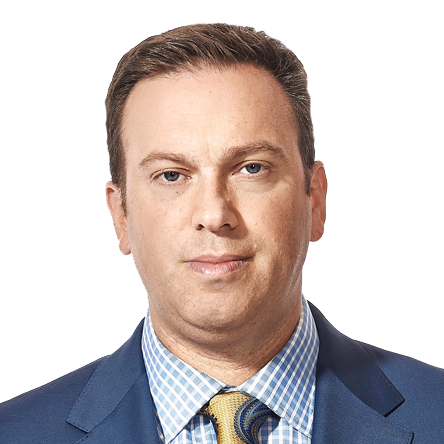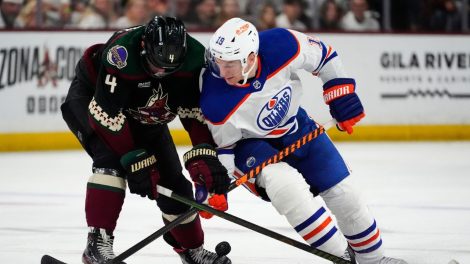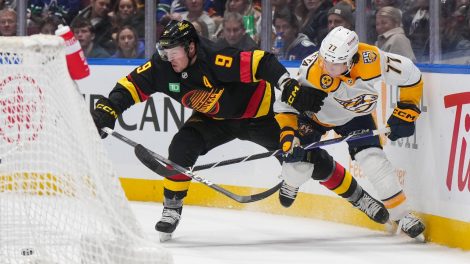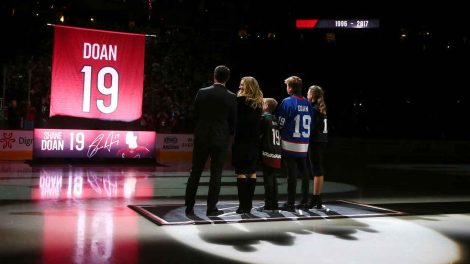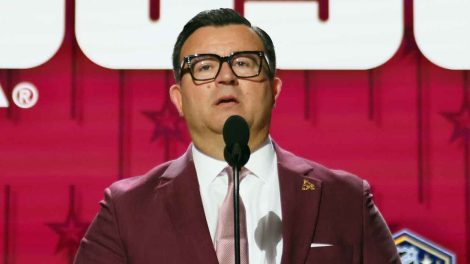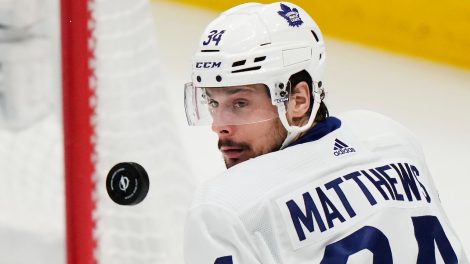• How Tyler Myers is preparing to play his weak side
• Have the Lightning uncovered another diamond in the rough?
• Henrik Zetterberg’s quiet farewell tour
In one of last season’s blogs, there was a note about NCAA Princeton asking NHL teams to limit their visits to certain times and practises. We’re going to start this week’s notes with a follow-up.
NHL teams are aggressive. There are always debates about how many US college free agents are real prospects, whether or not they are worth the attention they receive. But it’s a free look, no draft pick required and the salaries are set (although you can haggle over bonuses). So there is a chase, and it is fierce.
Years ago, one GM savaged another team’s executive for trying to get a player out of a verbal commitment to his club. “He does this all the time!” he screamed. Then he calmed down. “Man, he’s good at it. I wish he did it for us.” We both started laughing.
For many schools, it was out of control.
Princeton lost one, as forward Eric Robinson signed with Columbus. But there are three more with NHL interest: defenceman Josh Teves, forwards Ryan Kuffner and Max Veronneau. Teves, who is from Calgary, attended the Flames’ summer camp in 2017 and Vancouver’s this time. Kuffner and Veronneau are from Ottawa. The former skated for the hometown Senators after going to Winnipeg a year ago. Veronneau, the one with the most attention, was at Vegas in 2017 and New Jersey in 2018.
This year, the Tigers are trying to create order out of chaos.
“It was getting cumbersome,” head coach Ron Fogarty said Tuesday. “There were five or six teams after every game, they’d just get to say hi. It was irrelevant. The players didn’t like it. But when your goal is to make it to the NHL, there’s a great fear of saying no….you’re shutting out a team.”
Interested parties are allowed to schedule meals/meetings until Oct. 1. After that, there are only two other available “blocks.” The first is during American Thanksgiving. The second is just after the Christmas break from Dec. 29-Jan. 3.
“The players don’t make their decisions until after the trade deadline,” Fogarty said. “It comes down to the (NHL) roster, and their relationship with their advisor and the teams. If some of them circumvent the rules, the players will know. It comes down to character on both sides.”
Princeton is not the only team trying this, and barring specific legislation from the NCAA, there’s nothing that can completely prevent big-league skulduggery. But there are plenty of college coaches hoping it works.
[snippet id=3816507]
31 THOUGHTS
1. Another school that held an availability last week: Miami of Ohio. The Red Hawks gave interested parties a chance to meet 23-year-old defenceman Grant Hutton. Hutton, a right-shot from Carmel, IN., is a target. The estimate is 11 teams took advantage. With exhibition games underway, it wasn’t easy for general managers to attend, but one who made the time was Ottawa’s Pierre Dorion.
2. One interesting item about the Erik Karlsson deal: how involved the owners were. There was direct conversation between Ottawa’s Eugene Melnyk and San Jose’s Hasso Plattner. Prior to the trade, Plattner spoke to both Karlsson and wife Melinda twice each to answer any questions they had about the organization or the region.
“We are fortunate,” Sharks GM Doug Wilson said, “that we have an owner who considers it a priority to make himself available when we ask him.” (With more advance knowledge of the timing, Plattner attended the team’s post-draft John Tavares pitch in Los Angeles.)
In late July, during a calmer point in this process, Melnyk directly contacted Karlsson, asking for a face-to-face meeting to see where things stood. It never happened, as the two-time Norris winner indicated he wasn’t ready to decide his future and couldn’t guarantee when that would come. That was really the point of no return for the Senators.
3. Wilson keeps an internal stat that shows how the Sharks have averaged the NHL’s worst drafting position since 2003. The organization challenges itself to find players despite that handicap, and he credits his scouting staff for putting him into position to make big moves.
Judging from what Peter DeBoer did Saturday night vs. Vegas, it’s going to be Karlsson with Marc-Edouard Vlasic. Brent Burns was with Joakim Ryan and Brenden Dillon skated alongside Justin Braun. I assume there’d be situations where DeBoer re-unites Vlasic/Braun to protect leads. The Sharks were 16th in the NHL last season with the man advantage, an area they targeted to improve. Some of that was due to injury as Burns, Pavelski and Thornton were either banged-up or out entirely. On Sunday, they unveiled a first-unit power play featuring Burns, Karlsson, Logan Couture, Joe Pavelski and Joe Thornton. Sources say that’s…not bad.
4. Wilson wouldn’t comment, but it wouldn’t be a surprise if a team looking for power play help makes an offer for Tim Heed. The defenceman had two goals and three assists with the extra man in 29 games. It would be a surprise if he cleared waivers, so someone lower on the priority list might take a chance.
There were rumblings the Senators asked for Ryan Merkley in the Karlsson talks, but I don’t think that’s true. I also believe San Jose circled around Max Pacioretty, although that became less of a priority once Evander Kane was extended. But they kept an eye on him before he went to Vegas, just in case.
5. The NHLPA has another seven weeks to decide if it will appeal Tampa’s termination of Jake Dotchin’s contract, but how can it not? As one GM said Sunday, “What happens if some team is pissed off at someone with five years left on his deal, and he can’t do a pushup? Can he get cut, too?”
When news of the Lightning’s manoeuvre became known, there were a number of teams seeking additional information. Make no mistake, there was interest. Things cooled because of the impression this is an extreme case, with information the defenceman reported with 25 per cent body fat. I’m sensitive to this for two reasons: first, for much of the past 30 years, I’ve been way too fat myself. Second, you wonder if there’s a health reason this happened. Hopefully, that’s not the case.
[relatedlinks]
6. Tampa’s a tough organization. Last year, the Lightning battled with already-traded Jonathan Drouin, refusing to pay a 2016-17 bonus because the threshold was 0.73 points-per-game. Drouin finished at 0.726, with the team saying “rounding be damned, that’s below the line.” Eventually, they paid 90 per cent of the $212,500 amount before an arbitrator ruled on the case. Now this with Dotchin.
7. Some eerie similarities between Yanni Gourde, Jonathan Marchessault and Danick Martel. All listed at five-foot-nine or less. All undrafted after their QMJHL careers, despite averaging at least 1.4 points per game in their finales. Two 20-goal AHL seasons for Gourde, three for Martel, four for Marchessault. Quick, unsuccessful first tries at the NHL. Marchessault became a full-time NHLer at 25, Gourde at 26. Martel will be 24 in December. Does Lightning strike three times?
8. Kevin Bieksa said Tuesday that he was talking to an NHL team as recently as two weeks ago about something for this season, but ultimately said no because it meant living alone too far from his family. “My wife (Katie) is very supportive about me playing if I want to. Same with my father and my brothers. Saying no was not their decision. But being away from my children at this time in their lives is not something I’m interested in at this point in their lives.”
His son is turning 11, his daughter nine. He’s taking them to school every day, attending their extra-curricular pursuits, happy to be a dad. “I’m not retired, but it would have to be something close to home (California).”
9. Asked if he was still training, Bieksa answered. “Yes, as if I was going to play.” He’s scheduled to compete in what is called a Spartan obstacle race next month in Dallas. It’s a four-mile run with more than 20 obstacles. “I’m still in better shape than 95 per cent of the players and 100 per cent of the media.”
10. Winnipeg head coach Paul Maurice indicated the Jets will consider playing Tyler Myers on his weak side to start the year, and that’s on display in the pre-season. Myers trains in the summer with Adam Francilia, and, as Francilia says, “Tyler did bring it up. I think he had an idea it was a possibility.”
Unlike 2017, when Myers was recovering from injuries that ruined his season, he was healthy and raring to go. “You have a more positive mindset when you are not recovering,” the trainer said.
Here’s the question: Can you program your body specifically to play your off-wing? The answer is yes, there are things to try.
“You go to a primitive state of training. Your brain anticipates a certain way and you want to make physiological changes with the connective tissue. Tendon and ligaments adapt slower than muscles. It’s almost like a house built on cheap nails. If you build more on top of that, you’ve got a problem. When you’re five-foot-10 like I am, it’s easier to recover (if something goes awry). When you’re six-foot-eight like Tyler, it’s harder.”
The two did a lot of on-ice work with no stick to get Myers used to the different rotations and motions he’d need to play on the other side. Francilia feels Myers should be prepared to handle forwards who try to take him around the corners or drive deep.
11. Francilia, best known for work with goalies (Devan Dubnyk and Connor Hellebuyck among them) was rehired by former client Thomas Greiss. “He’s a specimen,” Francilia said of the Islander. “Huge legs. Huge calves. Ridiculous flexibility for that muscle. He’s got the ability to generate power. What we worked on was how to stop that power when necessary, so he can change direction and stay on top of the puck.”
12. Player in danger of being squeezed out: Dmitrij Jaskin, St. Louis. Lots of talented new blood there.
13. I think Philadelphia took a run at Artemi Panarin before signing James van Riemsdyk. That would have been a Gritty move.
14. It was well-reported last spring that Islanders GM Lou Lamoriello looked at Toronto assistant DJ Smith for the coaching position before hiring Barry Trotz. Apparently, Lamoriello also asked for permission to talk to another Leaf assistant, Jim Hiller. But I’m not sure an interview ever occurred.
15. Montreal’s Xavier Ouellet scored twice against Toronto on Monday. The Canadiens scouted him pretty heavily last season, but it seemed each visit coincided with a rough game for him. Nice to see something go his way as he re-starts his career.
16. In the 31 Thoughts podcast with Jeff Marek, Henrik Zetterberg admitted he traded sticks with a few long-time opponents towards the end of last season. “Some of those notes I wrote,” the Detroit captain said, “I think those guys probably knew that could be it.” He didn’t want to say who was involved, but under ferocious questioning, dropped a couple names.
“There’s a few guys you play a lot against throughout the years. (Sidney Crosby) is one of them. Obviously we had our battles throughout the years and he is a player that I respect a lot. (Joe) Thornton is another one that is outlasting me, but we had some good fights against each other.” There is a well-known story about Crosby using a photo of Zetterberg holding the Stanley Cup after Detroit’s 2008 victory over the Penguins as motivation during training for the next season. Zetterberg is skeptical that it is true. (It is.)
17. It’s September, everyone’s in great shape, in a great mood, optimistic about the season to come. But of all the comeback attempts, all of the players looking to resuscitate their careers, the one that grabs most is John McFarland’s.
Ten years ago, McFarland was the number one pick in the Ontario Hockey League, by Sudbury. Eight years ago, he was the 33rd selection in the big-league draft, by Florida. He was sent to the ECHL before he made the NHL, and the Panthers moved on after a three-game trial in 2015-16. He went to Finland and Switzerland, with his 2017-18 season ending in mid-November because of a right shoulder that needed surgery.
“It was a lingering thing,” McFarland said Sunday. “I’d gone (to Switzerland) knowing it wasn’t amazing. It needed to be reconstructed, from the collarbone to the shoulder itself.”
McFarland was back in the gym two weeks later, but wasn’t cleared for contact for five months. Meanwhile, his agent (Mark Guy) worked on finding new employment. There were overseas offers, but no real nibbles in North America. Then came a call from Edmonton’s assistant to the president of hockey operations, Bill Scott.
“They had some notes on me from the past, and I think he has a friend at the gym where I train. I’m very fortunate they called. Thankful. There were times after the surgery I worried I wasn’t going to get another job.” The Oilers signed McFarland to an AHL/ECHL contract. He was sent to AHL Bakersfield last week for the start of that training camp.
18. McFarland’s issue wasn’t behavioural (people say very good things about him), but he just wasn’t competitive enough to make the most of his skills. His brother, Paul, an assistant coach in Florida, is “a big part of my support system,” and the two worked hard to make sure John was prepared for this. “I had nerves at the start” of Edmonton’s camp, John said. “I tried to make myself realize I’ve been there before.”
Did the Oilers say much to you? “No,” he answered. “But I assume no news is good news. All I think about now is making Bakersfield. I’m more mature than I used to be, a better hockey IQ, I’ve learned little pieces from every coach that I had. I’m really excited to show what I am now.”
19. Florida made a captaincy change at the start of camp, with Derek MacKenzie handing the “C” to Aleksander Barkov. For one Panther, it was deja vu. Eight years ago, Roberto Luongo ceded the title to Henrik Sedin in Vancouver.
“I remember thinking that Henrik was ready to take over,” Luongo said last week. “There were no hard feelings. It was time to focus on playing goal and not on the other stuff.” Did he talk to MacKenzie to ease him through it? “He told me, we chatted for a few minutes. He understood, he’s been around a long time. Eventually we all knew it was coming. The future of our team is Barkov and the young guys. We know. Nobody had hurt feelings.”
Luongo laughed and said, “You have to remember how happy we were for Derek. It’s not often a fourth-line plug gets to be captain. Nothing changes, he’s still a leader.”
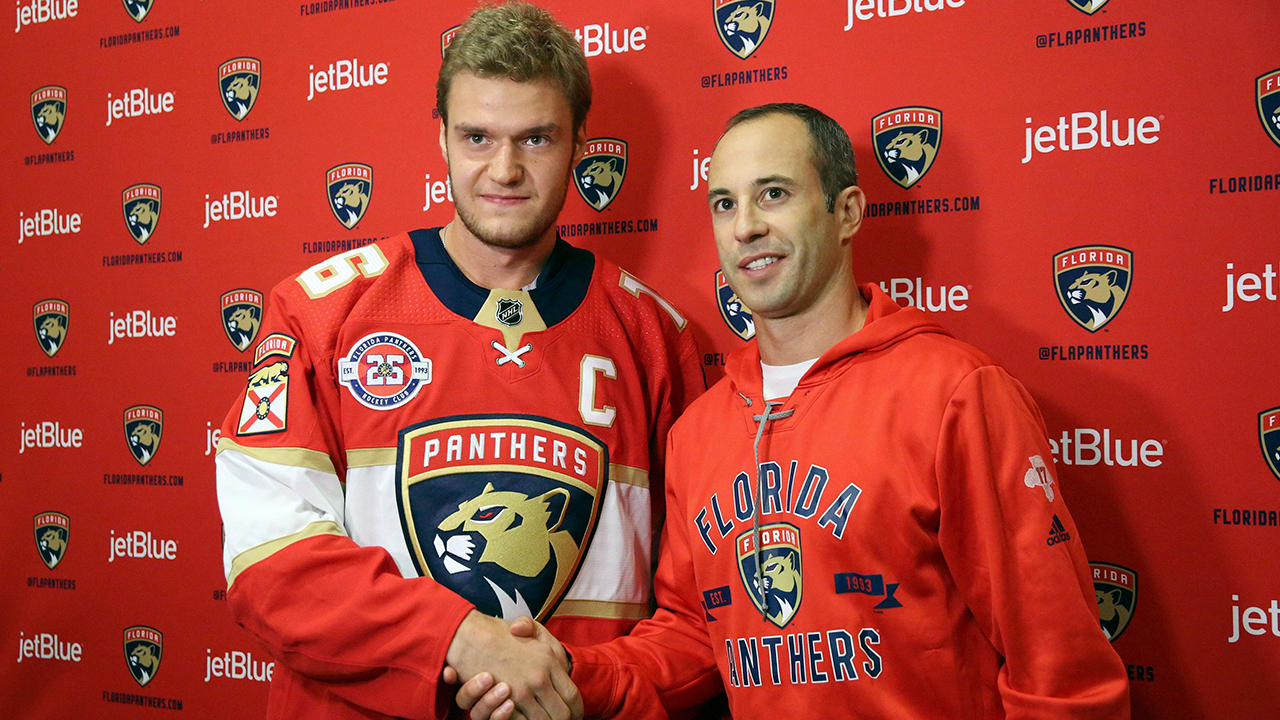
20. So, who will yell more, Barkov or Henrik Sedin? “Barkov might be even quieter than those guys,” Luongo answered. “I don’t think I ever saw Henrik lose it on the group. Besides, most successful captains keep their composure no matter what happens.”
21. At 39, Luongo will keep one tactic he developed last season, no practice the day after a game. That’s a concession for someone who used to hate missing even one practice. He played his first game of the season last week in Montreal, thinking, “Okay, I can still stop the puck, thank God.”
22. Finally, we were talking about all of the attention on Toronto so far, and whether or not players were getting tired of it. He had a great line: “Well, where we are there’s not a ton of news. But I’m sure in Vancouver they are not happy.”
23. Last week, when Max Domi punched Aaron Ekblad, one GM said before the hearing he knew this wasn’t going to end well.
“Count how many exhibition games Montreal has left,” he said. The number was five, which meant sitting him out for a regular-season game meant an in-person hearing and the eventual possibility of an arbitrator appeal. Player Safety and the NHL don’t like that route without precedent, and Domi’s action resulting in a six-game punishment (at least) probably wouldn’t stand.
I do think there were some who wanted Player Safety to push it, because they knew five games would look bad. But that sentiment didn’t carry the day. It will be interesting to see if this becomes a negotiating point in the next CBA talks, with the league asking for the option to suspend for regular-season games instead of a pre-season vacation. But, if you were the players, would you really want that? Right now, there’s zero real punishment.
24. One year ago, Mike Modano interviewed with Player Safety for a position there, a spot that went to Ray Whitney. Checked in recently, and, as he and wife Allison prepare for the arrival of their fourth child (due in October), they are also readying for a move. Currently in Arizona, they are building a place in Park City, UT, but are discussing a permanent locale.
“For us, it really comes down to where you want to raise the kids,” he said. But he still has the hockey bug and would like to get back in. “Absolutely, I miss it. I think of what a fit might look like.” With a young family, coaching or being a manager isn’t realistic for him, but there are a few other things Modano would like to try. “Television, work with a team’s foundation, their minor hockey program, corporate, I’d be available for everything. I’d go on the ice with prospects or go see them. I’m open to whatever’s out there.”
Modano has a history with Dave Tippett and has spoken to him about Seattle, but that’s on hold until the process is complete. It’s hard not to see the Minnesota connection. “We are midwestern people. I do have some connections with (Wild owner) Craig Leipold, but it’s not always right to be hired by the owner without the GM and coach. You want to have everybody on-board.”
[snippet ID=3322139]
25. I’m reading Gridiron Genius, the Michael Lombardi book about his football life and times with Bill Belichick and Bill Walsh. (Review: it’s freaking great.) There are so many worthwhile lessons and comments, but one that stuck out was that after the 2015 season, the Patriots did a ton of research into how to coach and reach millennials. Lombardi doesn’t go any deeper into it, but it reminded me of an interesting presentation last summer at the The Coaches’ Site Hockey Coaches’ Conference last July in Toronto.
Ottawa’s Marc Crawford was one of the speakers. He briefly spoke, then turned it over to son Dylan, who is AHL Belleville’s video coach. After he was done, up came his sister, Katie, who is taking her Masters at the University of British Columbia in sport exercise and health psychology. Her talk was about understanding millennials. And when she was done, the coaches in attendance made a beeline for her. Didn’t matter if they coached boys or girls, they wanted more information. “I thought no one would be interested,” she recalled when we spoke on Sunday. “I was shocked at how many people came up.”
26. Her dad’s profession had Katie interested in hockey since birth, but that deepened after a couple of conversations between them. Marc told a story at the conference about a sports psychologist who spoke to the team, asking who amongst them used that kind of mental help? Each player answered, “I use them for this or that, and another said he used one to help control a nervous cough that occurred before competition.”
“The other players were very accepting,” Marc said. “Unlike my day, where the player would have been ridiculed.” Katie wasn’t surprised. “That was the first time he really saw the strength of the younger generation. I can’t coach D-zone coverage or breakout plays. But when (Marc) says to me, ‘I can’t reach these kids, I’d sit with him and say, ‘I’m the same age as they are now. I’m 25. Understand they are digital natives. The digital world is home for them. It’s natural. It’s the first time in history children are experts of something before their parents are. We always went to our parents to learn. Now they go us.”
27. Katie played five years of volleyball for the UBC Thunderbirds, so she’s seen coaching up front at this level. She says it is critical that organizations understand the changes in priorities. She indicates Generation X (born 1965-80) had key goals in early adulthood: leaving school, buying your first property, marriage, kids and a career. She cited research indicating there was a time when 75 per cent of women and 66 per cent of men did that by age 30. Now, Katie says, there are studies indicating it’s down to 13 per cent of women and nine per cent of men.
“You can’t re-teach them. It’s done. The old, ‘I’m the boss, what I say goes,’ is over. They want to have a part in the conversation. They are craving true intimacy, connection with their teammates and coach. A place to belong is important. The online world means more friends, but less deep friends. Blending-in, no room for individualism are not gonna fly. The selfless values hockey teaches are good, but it’s the way you mandate them that’s important.”
28. If you are interested in more, Crawford suggested two videos that sat with her: Simon Sinek’s Millennials in the Workplace, and a Scott Hess’ Ted-Talk, Millennials: Who They Are & Why We Hate Them. She did an internship with the Vancouver Canucks, which was more on the business side. But she’s very encouraged by Toronto hiring Dr. Meg Popovic as director of athlete well-being and performance.
29. Don’t get too excited about week one exhibition results. Now the lineups are filled with more legit NHLers, and those who seriously think they’ve got a chance to get there. This is a truer indication. We’re going to find how ready those who had good first weeks like Evan Bouchard (Edmonton), Dillon Dube (Calgary) and Max Lajoie (Ottawa) are.
30. The night before Kraft Hockeyville in Lucan, Ont., provided an opportunity to walk down Richmond Row, where I left many of my brain cells while attending the University of Western Ontario. Enjoying a pint at Barney’s, I met Jeff Hare, who played for the Mustangs’ 2002 University Cup champ, a 4-3 triple overtime victory over UQTR. Hare joked that he was robbed of an assist on the winning goal, not given credit for getting the puck back to Kelly Paddon, whose rebound was knocked in by Stacey Britstone. Maybe the official scorer can make the change.
31. Wanted to close this week’s blog with a link to the Senators’ GoFundMe for those affected by the Ottawa-area tornados. The initial goal was $50,000 — which the organization vowed to match. Thanks to your generosity, that total was surpassed, and now the target is $100,000. (Again, the team will match.) Any amount helps and you can contribute here.

